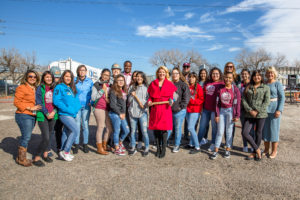
The agriculture industry may be the last great digital frontier.
It is the least digitized industry in the U.S. at a time when even the metrics for measuring tech adoption will be out of date the next day, according to a McKinsey Global Institute report. But, on the other side of the coin, those working to integrate tech into ag – with the goal of increasing efficiencies and profit margins – stand to make hay.
Agriculture is one of Colorado’s oldest industries and today creates $41 billion in annual economic impact. The values embedded in that heritage still permeate how many here learn to do business. Meet a startup, a major miller and a university who are leading
the tech charge to build a better ag system while keeping that Colorado spirit of doing business:
GeoVisual Analytics: “Let’s give you a tool to be as good as your grandfather.”
 Charles McGregor’s background is in intellectual property, not farming. As business unit manager for Boulder-based GeoVisual Analytics, he’s had a crash course in fresh produce – how it grows, what types of fungus can affect it and how he can help farmers plan better to improve their harvests and avoid food waste.
Charles McGregor’s background is in intellectual property, not farming. As business unit manager for Boulder-based GeoVisual Analytics, he’s had a crash course in fresh produce – how it grows, what types of fungus can affect it and how he can help farmers plan better to improve their harvests and avoid food waste.
“We want (farmers) to have transparency in the operations so they can have a better tool to make decisions,” he said. “We don’t tell farmers how to farm; we just give them more information and better tools to do the things they do better than anybody else.”
By using imagery collected through planes, drones and mobile phones, they can help farmers count their crops, get a full picture
of how close they are to harvest and what that harvest will yield. With the help of NASA-backed image analysis and artificial intelligence, farmers can build better crop forecasts. That also means they won’t have to overplant – McGregor says farmers often overplant fields by 30 percent.
It matters, he said, because “we have to get healthy food on people’s tables cost effectively.”
Getting into the California-based THRIVE AgTech accelerator and building industry partnerships gave them the “field cred” they needed among potential customers, and they solidify that cred by adding value quickly, McGregor said, particularly as many farmers retire and a new generation joins the field.
GeoVisual Analytics chose to do business in Colorado because “people genuinely want to work together,” McGregor said.
The tech opportunities in ag are practically endless, McGregor said – cautioning that it can be a problem: “Startups don’t die because of lack of opportunity; they drown in a sea of opportunity.”
That means testing and working closely with farmers is critical, said President and CEO Jeffrey Orrey: “Because there’s historically been so little technology in ag, that iterative process has been so critical.”
Ardent Mills: “You can change outcomes by working together.”
 With an innovation center that opened last year that includes a high-precision lab, a bakery to test grains and a research and development facility, Ardent Mills is committed to being on the leading edge. They upped the ante in March by announcing The Annex by Ardent Mills – a new specialty space where they are exploring what’s next in grains, particularly gluten free and ancient and heirloom varieties.
With an innovation center that opened last year that includes a high-precision lab, a bakery to test grains and a research and development facility, Ardent Mills is committed to being on the leading edge. They upped the ante in March by announcing The Annex by Ardent Mills – a new specialty space where they are exploring what’s next in grains, particularly gluten free and ancient and heirloom varieties.
“We’re a very big flour company but we want to be able to think small,” said Shrene White, the general manager of The Annex by Ardent Mills.
Being headquartered in Denver is important to this kind of innovation because of that agricultural history and the state’s love of gastronomy.
“It’s very much a foodie area,” Kent Juliot said of the state. As VP of research, quality and technical services – tasked with leading the development of new grain products – “we consider it a great advantage having our innovation center here.”
That foodie focus also allowed them to provide a “farm to fork” view of their business, from visiting a grower, to milling the grain, to testing it at the innovation center, to seeing those products used in a restaurant.
It also means they can forge strong relationships with growers, innovative universities like Colorado State – who workedwith them to develop a white whole-wheat variety called Snowmass – and with those who will eventually cook and bake with their products.
The Annex provides that opportunity to “cultivate new ideas, to build relationships,” White said.
And, those relationships with more than 1,000 farmers are critical as Ardent Mills helps them introduce new crops into their rotation and support sustainability practices, such as reducing water use and greenhouse gases.
“Really, it’s just helping them understand the tools that are out there,” White said.
Because of that trust, they can be a conduit to helping their farmers try new tech, said Ardent Mills COO Bill Stoufer: “We can put in technology on our end and when we sit down with the growers, they want to know.”
Colorado State University: “The interaction and collaboration built inside the building will be what makes this space important.”
 Colorado State University has broken ground on what will be a three-building campus at the National Western Center that will foster new ideas and research to feed and water a growing world.
Colorado State University has broken ground on what will be a three-building campus at the National Western Center that will foster new ideas and research to feed and water a growing world.
There will be 9 billion people in the world by 2050, said Amy Parsons, executive vice chancellor of the CSU System, and the food system in its current form cannot sustain that growth.
“Innovation is key to solving these immense issues, and collaboration has to be a large part of finding the answers,” Parsons said. “CSU has a long history of incubating new technologies, collaborating across industries and with other institutions, and providing the research to move concepts forward.”
CSU is one of five partners, which also include the City and County of Denver, the National Western Stock Show, the Denver Museum of Nature & Science and History Colorado, leading the redevelopment of the National Western Center.
The goal is for the renewed center to be a global destination for agricultural heritage and innovation. In addition to continuing to be home to the National Western Stock Show, the center will include three CSU buildings that focus on what’s next for the West, with a water resources center in partnership with Denver Water; a center that explores food systems and provides classroom and lab space as well as agribusiness incubation; and a facility for equine-sports medicine, equine-assisted therapies and education.
The build-out timeline for the National Western Center hasn’t been finalized, but there are estimates of a five-to-10-year build schedule for the CSU buildings.
Because of that timeline, CSU is working to build its presence in the community now in the Globeville, Elyria and Swansea neighborhoods. That means bringing in experiences that will be part of the future campus, from equine-assisted therapy and an annual health clinic for pets and their owners to providing free soil health kits and creating interactive science experiences at Bruce Randolph School.
With this campus, there will be space where people can share ideas and collaborate. That is critical to moving ideas forward and not isolating them in a research facility, Parsons said: “We cannot solve the problems we face without fresh approaches, and diverse minds.”
Sara Crocker is the communications manager for the Denver Metro Chamber
This was originally published in the Chamber’s magazine, Business Altitude. Click here to see the entire issue.
